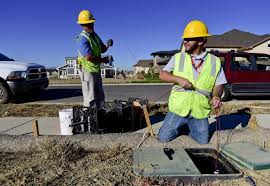What the F ?
Fiber has exploded in a big way over the past year. All the major telecom and cable companies have been making massive capital investments to replace their current network assets, which are becoming increasingly outdated and are costly to maintain.
Incumbent local exchange carriers (ILECs) (An ILEC is a telephone company in the U.S. that was providing local service when the Telecommunications Act of 1996 was enacted.) have been taking a beating by local cable companies who offer inexpensive big-bandwidth cable solutions. With their older and more unreliable copper network assets, these carriers are often hard-pressed to deliver comparable connectivity speeds. As a result, they’ve decided to fight back with fiber, frequently waiving the large up-front construction fees that previously made the investment in fiber cost-prohibitive for many organizations.
ILECs have also established Network Peering Relationships that enable them to participate in the increasingly competitive marketplace across the country. In other words, rather than only one option for fiber in a customer’s neighborhood, there could be multiple providers able to offer the same services, thus making pricing more competitive.
You may be wondering if all of this translates into a positive ROI investment for your business? What are the actual benefits of fiber?
Speed
Sandisk research indicates that slow internet connections cost employees one week per year in productivity. Think about that. While delays due to slow internet may seem negligible, over time, they add up. An organization shouldn’t notice Internet slow-downs during periods of high demand; similarly, Internet connections should never inhibit productivity. Fiber-optic Internet is exponentially faster than even the highest-speed coax connection, with options ranging from 5Mbps to 100 Gbps.
Reliability
The copper cabling of coax can result in weather stalling or damaging transmissions due to the copper cabling. In contrast, fiber Internet connectivity is much stronger than coax, offering negligible vulnerability to inclement weather. Additionally, unless the fibers are physically cut, fiber is resistant to human or electrical interference. Fiber Internet signals also do not degrade or disappear due to electromagnetic interference.
Unquestionably, unreliable Internet connections can have significant cost implications for a business. Dependence on reliable Internet to perform essential business functions, such as phone calls and critical applications. Unplanned downtime can bring an organization to a standstill, thus impacting productivity and potentially the bottom line.
Bandwidth
“Hitting the cap” on the monthly bandwidth allotment with cable Internet can be pretty easy, especially for businesses that have a high need for data transmissions. Fiber-optic Internet, on the other hand, while not truly unlimited, has substantially higher bandwidth than cable, reducing the likelihood of low bandwidth availability.
Some questions to consider in help determine if your business is suffering from low bandwidth include:
- Do you do File sharing?
- Is Web conferencing used today or planned for future?
- Do you Stream HD video?
- Does your business access cloud applications?
- Do you have SIP trunking today in place of analog phone lines?
Look out for the warning signs of low bandwidth availability: delays, slow speeds and pixelated video quality
Latency
Latency are the delays that occur while processing data over an Internet connection. Numerous delays can be experienced on cable Internet, particularly when uploading or downloading video or high-definition content. Although it’s unlikely that your employees are streaming Netflixs in their cubicles, businesses are impacted by latency in numerous ways. Decreasing latency can benefit your business by:
- Improved collaboration between employees
- Upload and download large files without disruption or delays
- Move more applications to the cloud
- Improved voice quality for VoIP users
Security
The average cost to a business from an information security breach is $3.8 million, and companies who have protected information leaked can face stiff financial penalties and customer defection.
Unfortunately, it’s easy for hackers and other nefarious cyber-criminals to gain access to sensitive information with cable Internet as a result of cable tapping or other fairly simple techniques. On the other hand, the only way to infiltrate a fiber-optic Internet is to physically cut the wires, causing the signal to vanish; therefore, a fiber internet connection is one of the single most powerful ways to increase a company’s cyber protection.
Although the media might focus on breaches of high-profile enterprise corporations, companies of all sizes are vulnerable to attack. Numerous SMB’s lack the money and resources to invest heavily in security, and many also have an “it can’t happen to me” type of mentality. The truth is quite the opposite, though. In reality, the likelihood of an SMB experiencing a cyber-attack or data breach is over 50% (Penemon Institute, 2017).
While upgrading to fiber Internet connectivity won’t prevent all customer risks, it can certainly be an initial step to protect them. Like a suit of armor, the knight may still get struck with his opponent’s sword, but he’s far less likely to be hit in a vital organ.
Cost-Efficiency
As previously mentioned, ILEC’s are taking strides to make the transition to fiber more affordable with Network Peering Relationships as well as a willingness to, in some cases, absorb the initial construction costs, which could save thousands of dollars in up-front capital expenditure. Fast Internet is increasingly being thought of as a critical productivity tool for business, despite it being costlier than coax. Consider the implications of a slow Internet connection across an organization. The number of employees affected by the slow-down multiplied by an average of a week’s worth of lost wages of a year—a simple cost analysis can show you that a business can actually save money by making the investment in fiber.
Keep in mind, the ever-increasing amount of data and applications being moved to the cloud. Businesses can increase flexibility and scalability by implementing fiber Internet to better serve their cloud initiatives, saving time and money. If your current internet connection just isn’t cutting the mustard, you could benefit significantly from an upgrade to a fiber-optic Internet connection.
Carol Bell 480-669-9598
Latest News
True or False
“A messy IT closet does not impact our equipment". Hello I hope you and yours are well. I want to say thank you to all my family,...
Big Plans?
What are your plans for the 4th? As we approach yet another holiday during the current COVID -19 pandemic, we are all painfully reminded...
Thank you
Enough said? No, Never. We can never truly express enough gratitude for our military of past and present who have made the ultimate...








